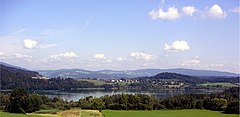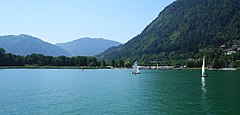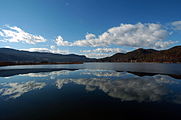Carinthian lakes
Since Carinthia is rich in lakes , the name Carinthian lakes has developed as a collective term, although it includes very different lakes: mountain lakes such as the Weißensee as well as moor lakes such as the Pressegger See , with limestone or primary rock subsoil. Almost all of them have in common the glacial formation and the strong silting up due to the abundance of nutrients. Exceptions to this are on the one hand gravel ponds such as the Silbersee , on the other hand reservoirs such as the Forstsee , which were artificially created.
description
The total area of the lakes in Carinthia is not particularly large compared to other areas. What is remarkable, however, is the diversity and diversity of the lakes in a small area. A special feature is the high surface temperature during the summer months. The Carinthian lakes are therefore an important factor in tourism.
There are 1270 stagnant bodies of water in Carinthia. Of these, 670 are over 1000 m above sea level. A. . The total area of all lakes is around 60 square kilometers, of which the four largest ( Wörthersee , Millstätter See , Ossiacher See , Weißensee) take up 50 square kilometers. The Faaker See , the Keutschacher See and the Klopeiner See are over a square kilometer. The deepest lake is Millstätter See with 141 meters, followed by Oscheniksee with 116 m before the damming, and Weissensee with 99 meters. The Millstätter See is also the lake with the most water with 1228 million cubic meters, ahead of the Wörthersee with 840 million cubic meters.
The creation of the lakes
The large Carinthian valley lakes (such as Wörthersee , Millstätter See , Ossiacher See ) were mostly formed during the retreat of the glaciers at the end of the last ice age . However, they were not simply dammed up by the ice age deposits. Their basins were tectonically given by old valley furrows. They lie in deep rock troughs that have been excavated by the glaciers in geological zones of disruption. For this reason, there are almost no lakes in the eastern parts (such as in the Lavant valley ) that were not icy.
The small lakes in the vicinity of Villach , for example the Magdalensee , are dead ice holes . When the Draugletscher retreated , large blocks of ice remained in the moraine material. After melting, the depressions of today's small lakes remained.
Most of the valley lakes are also located away from the main valleys. This saved them from being quickly filled up. At the same time, the mostly small tributaries cause a long water exchange time , which in turn promotes warming in summer. The small catchment area also causes relatively small fluctuations in the lake level over the course of the year.
View over the Faaker See towards Karawanken with the Mittagskogel
Body of water
High temperature in summer
Most of the bathing lakes usually reach a temperature of 20 ° C in mid-June, which they often maintain until September. The peak of warming falls in the second half of July. The high temperature of many Carinthian lakes is caused by a combination of the following factors:
- Low flow
- Intense sun exposure
- Lack of wind
Since the wind is not sufficient to mix the lake water in the deeper lakes, only the top water layer is mixed. In the course of the early summer, a layer of warm water of usually five to eight meters develops. The lighter body of warm water usually reaches 22 to 26 ° C, temperatures of 26 to 28 ° C are not uncommon in bays or near the shore. This warm water body ( epilimnion ) is separated from the deeper cold water body ( hypolimnion ) by a thermocline ( metalimnion ), where the temperature drops to around 4 ° C within a few meters.
In autumn this stratification is broken down by cooling. Then the wind can turn the entire body of water over ( holomixis ). This does not apply to all lakes. Some are characterized by the rare partial mixing or meromixis .
Meromixis
In the case of meromictic lakes, the wind energy in autumn and spring is not sufficient to circulate the entire water mass of a lake. This means that a water body close to the ground remains excluded from mixing all year round. These partially mixed lakes include Wörthersee (mixing depth 45–60 meters), Millstätter See (50–80 meters), Weißensee (40–60 meters), Klopeiner See (30 meters), Längsee (15 meters) and Goggau Lake (8 meters). The depth of mixing depends on the annual weather conditions. The phenomenon of Meromixis was first described in the 1930s by Ingo Findeegg at the Carinthian lakes.
The lack of mixing leads to a complete lack of oxygen in this area and therefore also to the absence of any animal colonization. However, this lack of oxygen is not a result of lake pollution, as Weissensee, for example, is one of the cleanest alpine lakes.
Usage aspects
Free access to the lake
Since the 1950s, private properties, but also those owned by the public sector, have increasingly been fenced off. While freely accessible lake plots were created as early as 1980/1990 on Upper Austria's Attersee , for example in Litzlberg , the same has only been criticized in Carinthia in recent years, in particular that the Wörthersee is "becoming increasingly private". For example, at the Forstsee power plant, the operator Kelag has signposted a bathing ban on the small jetty in Wörthersee in order to keep the jetty free for - very rare - moorings for motor boats (as of 2010/2015). A study commissioned by the Province of Carinthia and completed in 2016 showed that of the 10 largest Carinthian lakes, only 40 of the 150 public bank areas - i.e. around a quarter - are generally freely accessible to people.
“The lakes have to be accessible and tangible all year round,” propagates tourism officer Christian Benger (ÖVP) in line with the expectations of visitors to Carinthia. Study author Manfred Kohl pleaded "for more large, free access." He already promises for 2017 that 5 old beach baths could be opened. The action plan also includes the extension of the opening times of beach baths, the opening of hotel pools outside of the operating hours as well as a nationwide liability insurance for or for the operator. A new access was created on the north shore of Lake Wörthersee in 2016.
Motorboat licenses
Across Carinthia there are (as of September 2016) 444 licenses for (combustion) motor boats and 625 for electric (motor) boats. Of these, 330 and 500 were awarded for Lake Wörthersee alone. After the transfer of licenses for privately requested redemptions of up to several hundred thousand euros was customary in recent years, especially at Lake Wörthersee, after a court ruling in April 2016, on October 3, 2 p.m., a public reservation procedure in the state for licenses for the 3 lakes Wörthersee, Ossiacher was initiated and Millstätter See started. In the first 5/10 minutes or 2 hours there were 1,900 / 4,500 / 5,440 registrations from interested parties. No licenses are currently available. The yacht club complained about the "raid-like" new legal regulation, current license holders are expropriated, as it were, because the licenses would no longer have a replacement value with immediate effect. Existing licenses can exceptionally be passed on in the case of commercial use, inheritance, divorce or dissolution of a partnership.
Table overview
| Surname | Slovenian name | Municipality¹ | Area (ha) | Length (km) | Depth (m) | Altitude ( m above sea level ) | Specialty |
|---|---|---|---|---|---|---|---|
| Afritzer See | Field by the lake | 48.79 | 1.3 | 22.5 | 752 | ||
| Aichwaldsee | Dobiško jezero | Finkenstein | 3.32 | 0.5 | 7.2 | 634 | |
| Kirschentheuer bathing lake | Ferlach | 9.02 | 12 | 431 | Artificial swimming lake | ||
| Bass violin lake | Mlinarjev bajer (birt) | Keutschach | 2 | 2 | 515 | Also: Müllnersee | |
| Brennsee | Field by the lake | 41.2 | 26th | 740 | Also: Feldsee | ||
| Dietrichsteiner See | Feldkirchen in Carinthia | 6th | 4th | 650 | |||
| Dosen lake | Mallnitz | 13 | 0.7 | 44 | 2270 | Also: Dösnersee ; Karsee | |
| Egelsee | Spittal | 9.35 | 650 | Also: Ecksee | |||
| Faaker See | Baško jezero | Finkenstein | 220 | 2.3 | 30th | 554 | Private lake, island |
| Falkertsee | Reichenau | 4.32 | 0.3 | 13 | 1870 | ||
| Farchtensee | Stockenboi | 11.72 | 8.3 | 985 | |||
| Ferlach bathing lake | Boroveljsko pregradno jezero | Ferlach | 6.74 | 10 | 420 | Also: Ressnig pond | |
| Flatschacher See | Feldkirchen | 3 | 3.4 | 680 | |||
| Flattnitz lake | Flattnitz | 1.96 | 2.8 | 1400 | Also: Hemma lake | ||
| Fleetsee | Villach | 1.4 | 2.1 | 500 | |||
| Forest lake | Boršt | Techelsberg | 29 | 1 | 35 | 601 | Upper water for the Forstsee storage power plant (on Lake Wörthersee), a few meters deep, about 2 m level fluctuation, informal nudism |
| Freibach reservoir | Borovniško jezero | Cell | 43 | 1.2 | 33 | 736 | River power plant |
| Goggau lake | Steuerberg | 10.51 | 12 | 775 | |||
| Gösselsdorfer See | Goslinsko jezero | Eberndorf | 32 | 3 | 469 | ||
| Greifenburg bathing lake | Greifenburg | 5 | 14.5 | 590 | |||
| Grünsee | Villach | 1.76 | 6.6 | 490 | |||
| Hafnersee | Habnerjevo jezero | Keutschach | 15.93 | 10 | 510 | ||
| Haidensee | Glanegg | 1.38 | 6th | 486 | Dead lake | ||
| Hörzendorfer See | St. Vitus | 6.36 | 5 | 517 | |||
| Keutschacher See | Hodiško jezero | Keutschach | 132.7 | 2 | 15.6 | 506 | FKK - Camping |
| Kleinsee | Malo Jezero | St. Kanzian | 9 | 9 | 448 | 20–40 m wide water lily and reed belt | |
| Klopeiner See | Klopinjsko jezero | St. Kanzian | 110.6 | 1.8 | 48 | 446 | Warmest bathing lake in Carinthia |
| Kraiger See | Frauenstein | 5.1 | 10 | 596 | |||
| Längsee | Dolgo jezero | St. Georgen | 74.85 | 1.3 | 21.4 | 550 | Contrary to its name, the lake is rather round |
| Leonharder See | Villach | 2.29 | 6.5 | 520 | |||
| Linsendorfer See | Gallicia | 3 | 7.5 | 403 | |||
| Magdalensee | Villach | 14.11 | 5.2 | 486 | |||
| Maltschacher See | Feldkirchen | 12.9 | 6.7 | 594 | |||
| Millstätter See | Millstatt am See | 1328 | 11.8 | 141 | 588 | The deepest and most water-rich Carinthian lake | |
| Moosburger Mitterteich | Moosburg | 17.35 | 3 | 510 | |||
| Moosburger mill pond | Moosburg | 3.9 | 5 | 503 | |||
| Lavamünd natural bathing lake | Lavamünd | 0.88 | 6th | 350 | |||
| Ossiacher See | Osojsko jezero | Ossiach | 1078.5 | 10.2 | 52.6 | 501 | |
| Penkensee | Rupratov bajer (birt) | Keutschach am See | 5.16 | 620 | |||
| Pirkdorfer See | Breško jezero | Feistritz ob Bleiburg | 3.5 | 3.5 | 504 | Gravel pond with a natural inflow | |
| Pischeldorfer bathing pond | Magdalensberg | 0.75 | 2.4 | 465 | Artificial bathing pond | ||
| Pöllaner pond | Pollan | 1.1 | 626 | ||||
| Pressegger See | Preseško jezero | Hermagor | 55.28 | 1 | 13.7 | 560 | Preserved moor belt |
| Rauschelesee | Rijavško jezero | Keutschach | 19.1 | 12 | 510 | ||
| Saisser See | Zajzersko jezero | Velden | 13.3 | 6.6 | 593 | Also: Jeserzer See | |
| Silver lake | Villach | 8.4 | 7th | 492 | Gravel pond | ||
| Sonnegger See | Sonnegg | 1.7 | 4.5 | 468 | Artificial swimming lake | ||
| Spin ponds | Špintikov bajer (birt) | Keutschach | 7.6 | 0.4 | 560 | Nature reserve | |
| St. Andräer See | St. Andrä | 2.48 | 5 | 393 | Artificial swimming lake | ||
| St. Johann bathing lake | Fixed scratch | 12.08 | 13 | 439 | |||
| St. Urban Lake | Santa Urban | 9 | 3 | 745 | |||
| Stappitzer See | Mallnitz | 3.6 | 0.214 | 6th | 1273 | ||
| Soot pond | Moosburg | 26th | 2 | 552 | Private ownership, landscape protection | ||
| Tigringer See | Tigring | 1.7 | 2 | 546 | Naturist campsite | ||
| Trattnigteich | Schiefling | 5.31 | 3 | 570 | |||
| Turnersee | Zablaško jezero | St. Kanzian | 44.16 | 13 | 481 | Preserved moor belt | |
| Turracher Schwarzsee | Reichenau | 2.6 | 4th | 1840 | Mountain lake, partly in Styria | ||
| Turracher See | Reichenau | 19.43 | 33 | 1780 | Also: Turrachsee ; Mountain lake, partly in Styria | ||
| Vassacher See | Vaško jezero | Villach | 4.43 | 10.2 | 520 | ||
| Wangenitzsee | Winklern | 21.57 | 0.7 | 48 | 2465 | Largest mountain lake in Carinthia | |
| Weissensee | Belo Jezero | Weissensee | 653.1 | 11.6 | 99 | 930 | Highest of the large Carinthian bathing lakes, ice skating |
| Wernberg bathing lake | Wernberg | 4.5 | 15th | 492 | |||
| Wolayer lake | Lesachtal | 3.8 | 13.9 | 1951 | Mountain lake | ||
| Wörthersee | Vrbsko jezero | Klagenfurt | 1939.75 | 16.5 | 85.2 | 439 | Largest Carinthian lake, historic ships |
| Zmulner See | Liebenfels | 1.82 | 7.5 | 523 | Also: Moosebauerteich ; Dead lake |
¹If the lake is spread over several municipalities, the name giving the lake is given first, otherwise the largest.
See also
Web links
swell
- ↑ Carinthian Lakes. In: kis.ktn.gv.at. Retrieved September 20, 2018 .
- ↑ Lake study: only a quarter freely accessible orf.at, November 3, 2016, accessed November 4, 2016.
- ↑ Boat licenses for everyone now orf.at, October 3, 2016, accessed October 3, 2016.
- ↑ Flattnitz Lake. Retrieved February 6, 2013 .
- ↑ a b Overview of the lake ( memento of the original from June 25, 2008 in the Internet Archive ) Info: The archive link was inserted automatically and has not yet been checked. Please check the original and archive link according to the instructions and then remove this notice. at Umwelt-barrierefrei.ktn.gv.at
- ↑ Haidensee ( Memento of the original from December 28, 2014 in the Internet Archive ) Info: The archive link was inserted automatically and has not yet been checked. Please check the original and archive link according to the instructions and then remove this notice. kis.ktn.gv.at (PDF)
- ↑ fishin2.net ( Memento of the original from September 6, 2007 in the Internet Archive ) Info: The archive link has been inserted automatically and has not yet been checked. Please check the original and archive link according to the instructions and then remove this notice.
- ↑ kath-kirche-kaernten.at ( Memento of the original from October 4, 2007 in the Internet Archive ) Info: The archive link was inserted automatically and has not yet been checked. Please check the original and archive link according to the instructions and then remove this notice.
- ↑ volksgruppen.orf.at
- ↑ majda.at
- ↑ Gerfried Horand people: Peter Peball (1882-1918). Teacher and florist. In: Carinthia II. 169_89, 1979, pp. 133-136, entire article pp. 129-136, PDF on ZOBODAT .
- ↑ flickr.com
- ↑ Meinekleine.at
- ↑ maps.google.at
- ↑ slovensko / 99Skialpin0405.shtml ( Memento of the original from March 23, 2005 in the Internet Archive ) Info: The archive link was inserted automatically and has not yet been checked. Please check the original and archive link according to the instructions and then remove this notice.
- ↑ www.austria.info/ area / 461826
- ↑ ethnic groups slovenia
- ↑ Zmulner See ( Memento of the original from March 6, 2016 in the Internet Archive ) Info: The archive link was inserted automatically and has not yet been checked. Please check the original and archive link according to the instructions and then remove this notice. kis.ktn.gv.at







